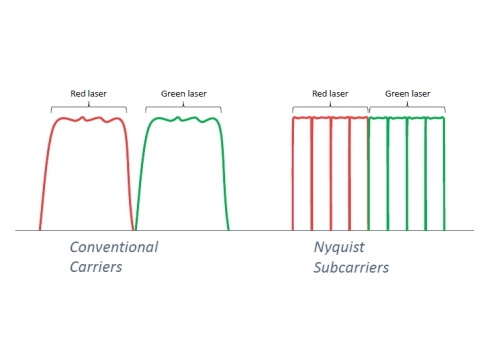SAN DIEGO--(BUSINESS WIRE)--Ninth paragraph of release dated February 25, 2019, should read: Information was sent through the MAREA cable via high-speed lasers. Using their own high-tech toolkit to modulate the lasers, Infinera generated signal speeds topping out at 26.2 terabits per second, a 20 percent increase over what the cable designers originally thought feasible.
The corrected release reads:
RESEARCHERS BREAK EFFICIENCY RECORD FOR DATA TRANSFER IN ULTRA-FAST TRANSATLANTIC CABLE
A new experiment has achieved a record fiber optic cable capacity of 26.2 terabits per second across more than 6,000 kilometers of the MAREA transatlantic fiber optic cable
If you are making an overseas phone call or using cloud computing, there is a 99 percent chance an undersea fiber optic cable is being utilized. Now, new work with lasers shows promise for squeezing more data through these cables, to help meet the growing demand for data flow between computers in North America and Europe. The method could increase network capacity without requiring new cables, which can cost hundreds of millions of dollars to build.
A team of researchers from Infinera has achieved new benchmarks for efficiency for transatlantic fiber optic cables. Testing an emerging approach for how the light signals are transmitted -- called 16QAM modulation -- the group smashed through efficiency records for data transfer, nearly doubling data capacity and approaching the theoretical limit for such a transfer. They will present their research at the upcoming Optical Fiber Conference and Exposition, held 3-7 March in San Diego, Calif., U.S.A.
“In an optical fiber, it’s desirable to carry more data per second, which we call the fiber capacity, and also to be able to send the signal over longer distances, which we call the optical reach,” said Dr. Pierre Mertz, an author on the study. “In simple terms, if you try to push the limits of fiber capacity you will reduce the reach. “
The team managed to extend record-setting capacity for a given reach -- across the Atlantic Ocean -- using the MAREA transatlantic cable, which spans 6,605 kilometers from Bilbao, Spain, to Virginia Beach, Va., U.S.A. Funded in part by Microsoft and Facebook, MAREA currently holds the record for the highest-capacity cable crossing the Atlantic Ocean.
The MAREA cable came online last year and is made of eight pairs of optic fibers, with each pair designed to carry 20 terabits per second -- each one enough to stream more than 4 million HD videos at once.
Demand for new and better cables has risen ever since the first undersea trans-Atlantic communications cable was laid in 1858. That demand has skyrocketed over the last decade, thanks to the shift to cloud-based computing.
Indeed, Virginia and North Carolina have become hotbeds for building data centers, especially since the MAREA cable went live in February 2018. The recent construction includes four data centers for Microsoft alone.
Not only does the new experiment mark the first time PM-16QAM signals were sent such distances, Mertz said, the feat was achieved with equipment readily available to the industry.
Information was sent through the MAREA cable via high-speed lasers. Using their own high-tech toolkit to modulate the lasers, Infinera generated signal speeds topping out at 26.2 terabits per second, a 20 percent increase over what the cable designers originally thought feasible.
The biggest challenge is that the system was operating very close to the Shannon Limit, or the theoretical maximum information transfer rate for a communications channel, according to Mertz. "That means that every gain we make becomes harder and harder,” he said.
This result is already delivering comparable capacity to next-generation chipsets from other vendors that employ a technique called probabilistic constellation shaping (PCS). The good news for service providers demanding ever more capacity, Mertz said, is as the industry moves toward higher-performance systems, their technique can be combined with PCS for even faster speeds in the future.
Additional research results will be presented onsite at OFC 2019.
Hear from the research team: “Real-time 16QAM Transatlantic Record Spectral Efficiency of 6.21 b/s/Hz Enabling 26.2 Tbps Capacity” by Stephen Grubb, Pierre Mertz, Ales Kumpera, Lee Dardis, Jeffrey Rahn, James O’Connor, Matthew Mitchell, will take place at 12:15 p.m. Monday, 4 March in Room 6D of the San Diego Convention Center.
MEDIA REGISTRATION: Media/analyst registration for OFC 2019 can be accessed online. Further information is available on the event website at OFC, including travel details.
About OFC
The Optical Fiber Conference and Exhibition (OFC) is the largest global conference and exhibition for optical communications and networking professionals. For more than 40 years, OFC has drawn attendees from all corners of the globe to meet and greet, teach and learn, make connections and move business forward.
OFC includes dynamic business programming, an exhibition of more than 700 companies, and high impact peer-reviewed research that, combined, showcase the trends and pulse of the entire optical networking and communications industry. OFC is managed by The Optical Society (OSA) and co-sponsored by OSA, the IEEE Communications Society (IEEE/ComSoc), and the IEEE Photonics Society. OFC 2019 will be held from 3-7 March 2019 at the San Diego Convention Center, California, USA. Follow @OFCConference, learn more at OFC Community LinkedIn, and watch highlights on OFC YouTube.
Authors: Stephen Grubb, Pierre Mertz, Ales Kumpera, Lee Dardis, Jeffrey
Rahn, James O’Connor, Matthew Mitchell
Author Affiliations: Infinera
Contact:
PMertz@infinera.com

